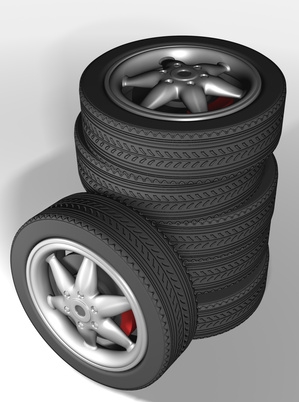
Installing the right size tire on a set of wheels can seem confusing, given the number of sizes and styles of wheels and types of tires. Fortunately, what size of tire you should get for your vehicle's wheels is based on one main criteria, which is the size of the wheel. You don't want to install a tire that is too narrow or too wide for a wheel, since it may adversely affect the handling.
Determine the width of your existing tires. If your vehicle has the same tires that were fitted to it by the manufacturer, than you are probably safe simply installing the same size tire. The width of the tire is imprinted on the outside edge of the tire. There will be series of numbers. For example, they may say 205/60R15. The "205" is the width of the tire in millimeters, the "60" is the tire's profile (relation of the sidewall to the width) and the "15" is the diameter of the wheel in inches.
Figure out the diameter of your wheels. In order for a tire to fit on a wheel, the tire must be the same diameter of the wheel. Use a tape measure to measure the face of the wheel or look at the numbers on the tire to determine the diameter of the wheel.
Determine the size of you wheels. If you want to change the size of your tires and go to a wider or narrower tire, or if there are no tires currently fitted to your car, find out what size tire to use based on the width of your wheels. This is sometimes stamped on the front or back of the wheel. You can also measure the width of the rim if there is no tire mounted by measuring the distance from the outside lip to the inner lip. There is a range of tire sizes that will fit on a wheel. There are many different variables here, so consult a chart like the one that Custom Wheels Market has on their site that covers compatible wheel and tire sizes.
Decide what you want out of the tire. If you want more performance, than go with a wider, lower profile tire. The added width will provide more grip, while the lower profile will potentially offer a stiffer sidewall and more response during cornering. If on the other hand, fuel economy is your primary concern, than go with a narrow tire that will offer less rolling resistance and provide better mileage.